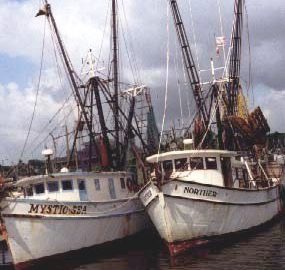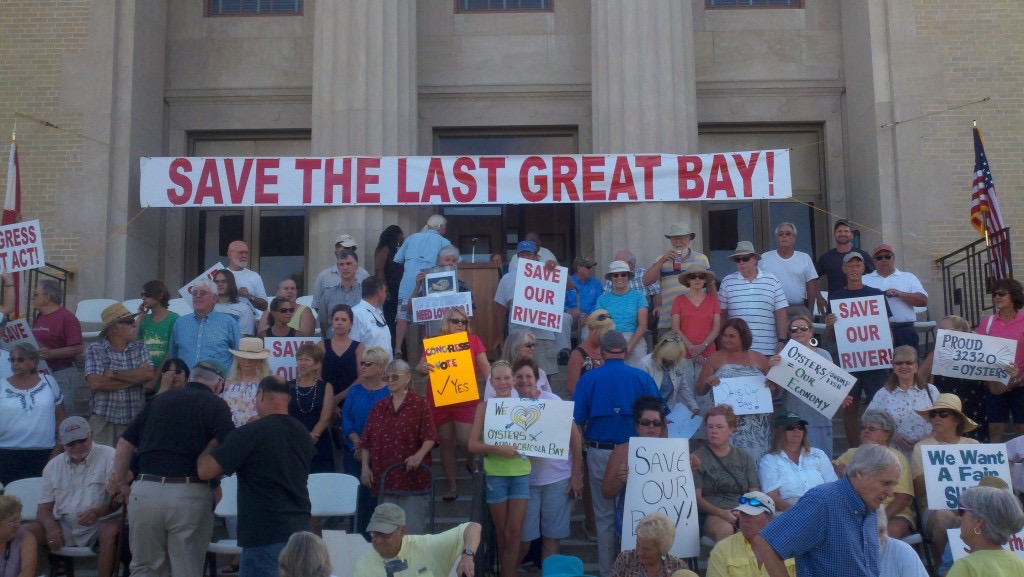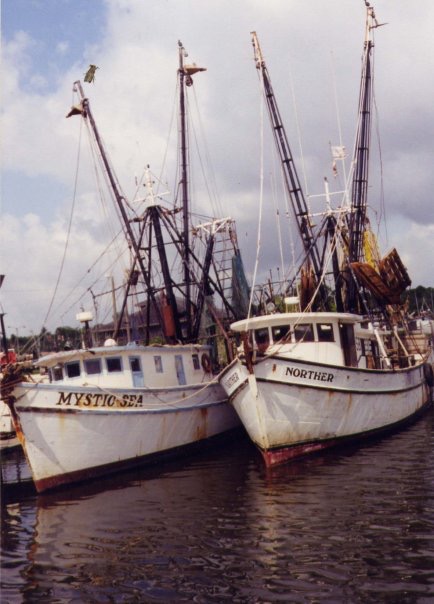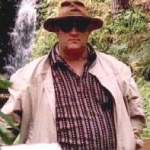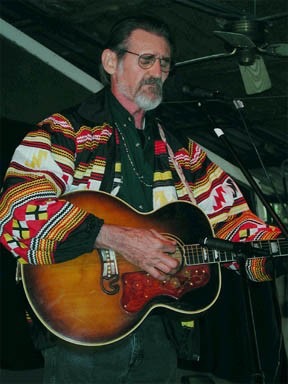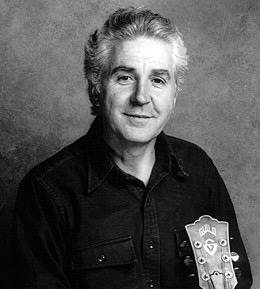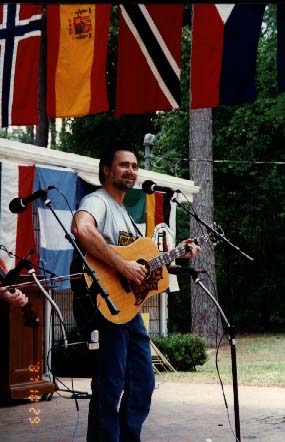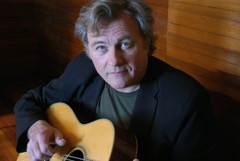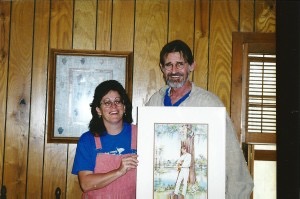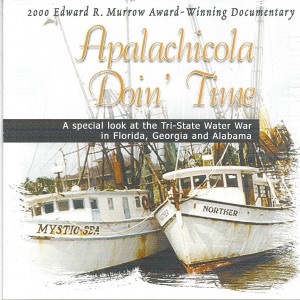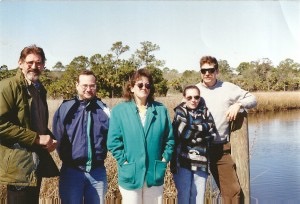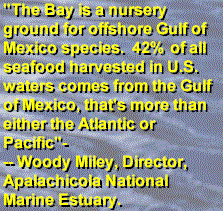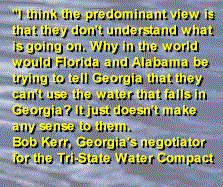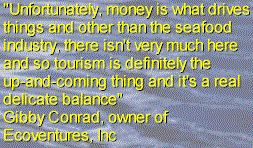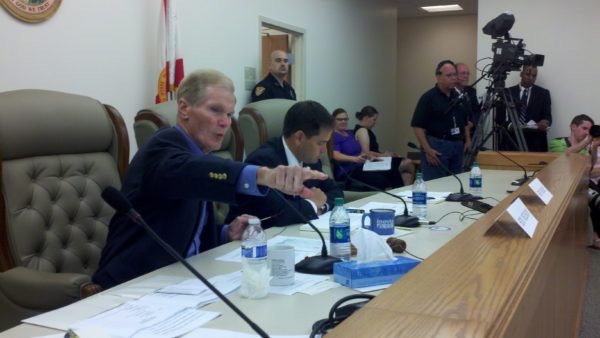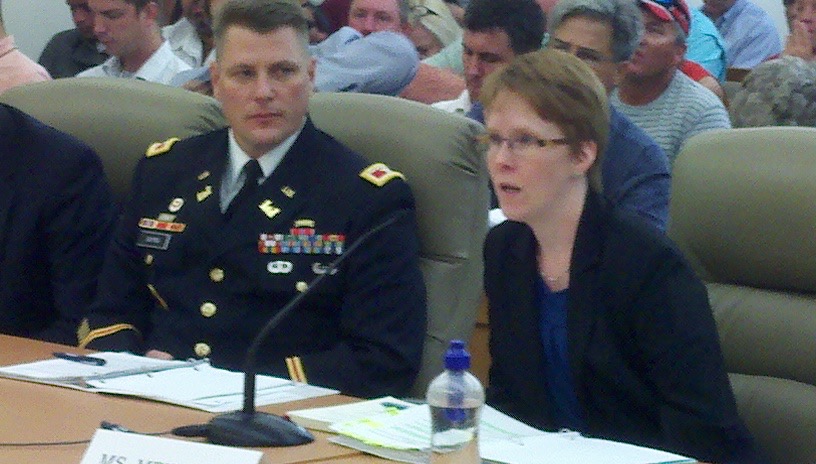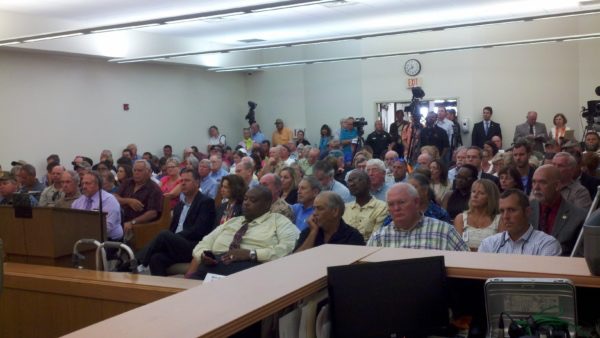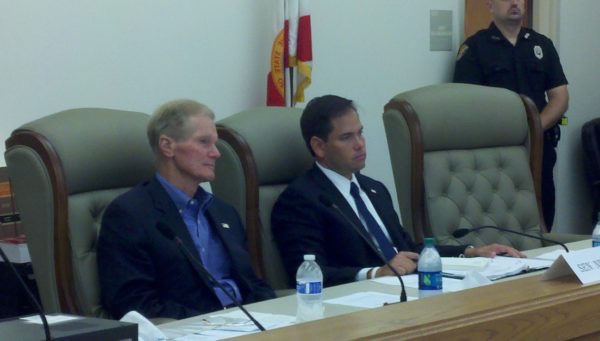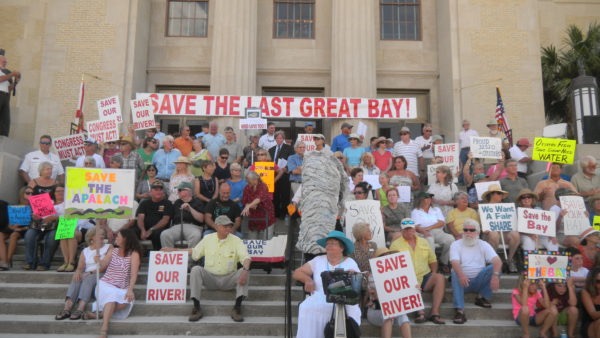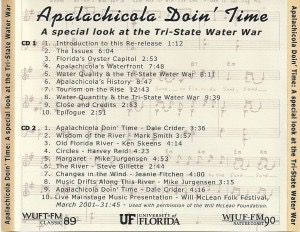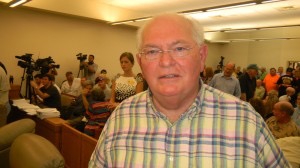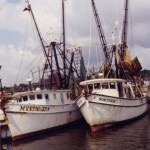“APALACHICOLA DOIN’ TIME” documentary full written script with photos and music below.
(All photos by Donna Green-Townsend)
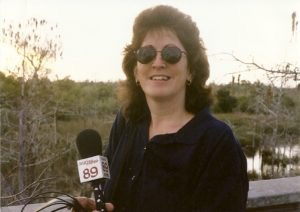
Editor’s Note: Despite the fact it’s been nearly 20 years since this documentary first aired nationally, the Tri-State-Water War has continued to make headlines as the issue works its way through the courts. The key political players involved, including presidents, governors, lawmakers, judges and regulators, have changed many, many times. Nevertheless, the issues remain the same as the three states involved: Florida, Georgia and Alabama continue to fight over the Apalachicola/Chattahoochee River System they all share.
In the documentary, which originally aired across the country on Public Radio in October of 1999 (and rebroadcast in 2002) we examined the potential impact of the water war on the seafood community of Apalachicola on Florida’s Gulf Coast in Florida’s Panhandle. We looked at the history and culture of this historic seafood community and examined the water quality and water quantity issues being debated by water negotiators.
 “Apalachicola Doin’ Time” was co-produced by Bill Beckett. The associate producers were Joshua Azriel and Daniel Beasley. The documentary received the prestigious National Edward R. Murrow Award for Best Documentary in 2000 from the Radio and Television Digital News Association.
“Apalachicola Doin’ Time” was co-produced by Bill Beckett. The associate producers were Joshua Azriel and Daniel Beasley. The documentary received the prestigious National Edward R. Murrow Award for Best Documentary in 2000 from the Radio and Television Digital News Association.
Listen to the radio documentary. See additional updates and material related to the Tri-State Water War . Learn more about the artists performing in the documentary.
Full transcript of the documentary
Sound of river water flowing
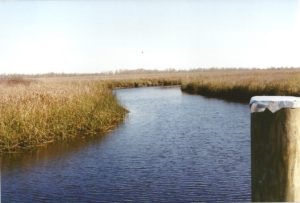 Two hundred yards below the Appalachian Trail the waters of the Chattahoochee River begin a 500 mile journey south. The river flows each day through Atlanta, past Western Georgia cities like Columbus…and along the state boundary between Georgia and Alabama…past more than a dozen dams and locks on the way to the Gulf of Mexico. At the Florida-Georgia border the Chattahoochee meets up with Georgia’s Flint River and takes on a new name: The Apalachicola. Sixteen billion gallons of water flow down the Apalachicola into the Bay every day making it Florida’s largest waterway and it’s at the heart of a Tri-State Water War:
Two hundred yards below the Appalachian Trail the waters of the Chattahoochee River begin a 500 mile journey south. The river flows each day through Atlanta, past Western Georgia cities like Columbus…and along the state boundary between Georgia and Alabama…past more than a dozen dams and locks on the way to the Gulf of Mexico. At the Florida-Georgia border the Chattahoochee meets up with Georgia’s Flint River and takes on a new name: The Apalachicola. Sixteen billion gallons of water flow down the Apalachicola into the Bay every day making it Florida’s largest waterway and it’s at the heart of a Tri-State Water War:
Apalachicola Doin’ Time song by Dale Crider up full
 In this documentary we’ll take you on an audio journey to the community at the end of the drainpipe so to speak–Apalachicola, a Florida seafood community that worries about being at the mercy of it’s northern water using neighbors.
In this documentary we’ll take you on an audio journey to the community at the end of the drainpipe so to speak–Apalachicola, a Florida seafood community that worries about being at the mercy of it’s northern water using neighbors.
Also on this journey we’ll travel to the city’s famous waterfront. Hear about the history of this unique river town and find out how the community’s affected by the rapid development of ecotourism and growth .
We’ll also talk with the key negotiators involved in the current water war involving Alabama, Florida and Georgia as the clock ticks down on a deadline to resolve differences over shared river resources.
Apalachicola Doin’ Time Song by Dale Crider up full
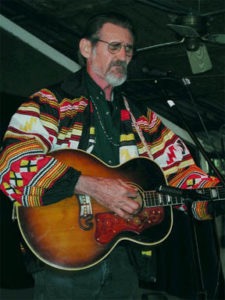
About three decades ago the Army Corps of Engineers began construction of more than a dozen dams and reservoirs on the Chattahoochee/Apalachicola River system. Its goal….to meet navigational and recreational needs of boaters. Georgia and Alabama also saw these structures as a way to store up water for industrial use, agricultural needs and for future drinking water. The projects worried retired wildlife biologist Dale Crider from the Florida fish and wildlife conservation commission. Nearly 30 thirty years ago Crider began to put his concerns into music:
Dale Crider: “And we got concerned here in Florida that that would be destructive to the fish and wildlife values of the river. So I started writing stories and songs about that story of losing a river to navigational development. So um I came up with this notion that the river was just doing time for human beings, you know we had her like a prison with all these locks and dams and everything. That’s how the thread of the song came from.”
Song comes up full and under
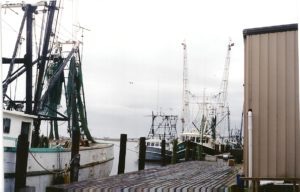 There’s a lot at stake for all three southern states. Rapid growth in Atlanta creates a strong need to secure drinking water for the future. Farmers want to maintain the ability to irrigate their crops. Alabama residents want to maintain peak hydropower and navigational use and in Florida. At the end of the Apalachicola River the seafood industry worries about the future of its oysters, scallops, crabs and shrimp.
There’s a lot at stake for all three southern states. Rapid growth in Atlanta creates a strong need to secure drinking water for the future. Farmers want to maintain the ability to irrigate their crops. Alabama residents want to maintain peak hydropower and navigational use and in Florida. At the end of the Apalachicola River the seafood industry worries about the future of its oysters, scallops, crabs and shrimp.
Montage of teaser bites about the water war
Waterfront Sounds
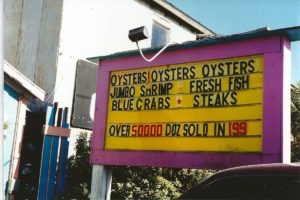 The sign outside the waterfront restaurant “Boss Oyster” brags 50-thousand dozen served. Owners say that number refers to 1997. Last year (1998) they served more than 80-thousand dozen oysters steamed and raw. (Oyster Radio Sound) Even a local radio station proudly advertises itself as Oyster Radio. Apalachicola is truly the Oyster capitol of Florida. Franklin County harvests more than 90 per cent of the state’s oysters and 10 per cent of the national supply and during good harvest seasons that’s three to six-million pounds of oyster meat.
The sign outside the waterfront restaurant “Boss Oyster” brags 50-thousand dozen served. Owners say that number refers to 1997. Last year (1998) they served more than 80-thousand dozen oysters steamed and raw. (Oyster Radio Sound) Even a local radio station proudly advertises itself as Oyster Radio. Apalachicola is truly the Oyster capitol of Florida. Franklin County harvests more than 90 per cent of the state’s oysters and 10 per cent of the national supply and during good harvest seasons that’s three to six-million pounds of oyster meat.
Bobby Kirvin: “Ain’t no one eats more than I do. I eat them on the average of twice a week and in the winter months I eat them four times a week.”
Lifelong Apalachicola fisherman and seafood operator, Bobby Kirvin:
Bobby Kirvin: “And when you eat a raw oyster, you’re eating him functional, he’s gut feathers and all. Uh, that’s a fact. If you think about it, you don’t eat’em, but they are delicious.”
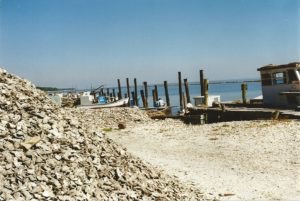 Bobby Kirvin likes to talk about the good old days in the seafood business, before the Water Wars, before Florida’s constitutional ban on the use of gill nets which put many mullet fisherman out of business and before government regulations got tighter.
Bobby Kirvin likes to talk about the good old days in the seafood business, before the Water Wars, before Florida’s constitutional ban on the use of gill nets which put many mullet fisherman out of business and before government regulations got tighter.
Bobby Kirvin: “I was in the oyster business for years. I was the largest oyster operator in the oyster business that was here. We had 100 and something stalls. The day my daddy retired back in the late 70’s I shut it down. Too much aggravation, too many people involved in it.”
So Kirvin retired about eight years ago and left the oyster and shrimp business to his sons and many other young families in Apalachicola, a fact he’s proud of.
Bobby Kirvin: “Mine was a 15-million dollar operation at that time. There’s nobody ever been in Apalachicola in the seafood business that’s made as much money as I made. None. And I helped more people get on their feet than anybody’s ever been in Apalachicola. The men that worked with me now they own fleets of shrimp boats and I financed their first boats for them.”
Sounds of the waterfront and docks
The oyster business isn’t the only industry bringing in big bucks to Apalachicola. Shrimp, scallops, crab and fin fish also impact Franklin County’s economy……to the tune of fourteen million dollars. Some retail figures for the areas seafood reach as high as one-hundred million by the time the product makes it to restaurant tables.
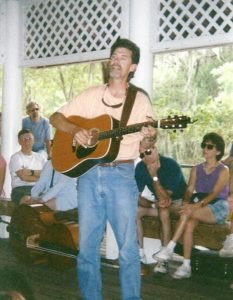
Wisdom of the River song by Mark Smith
It’s a typical work day on Apalachicola’s waterfront. The “Tina Marie” is pulling into the dock.
Sound of dock up full
Waiting at the dock is Joey Ward, one of four brothers and a dad operating Buddy Ward & Sons Seafood. It’s a true family operation.
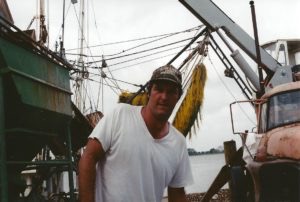
Joey Ward: “It’s all of us, Dakie, Tommy, George and myself. My father’s Buddy Ward. He’s the big wheel.”
There was another brother besides Dakie, Tommy, George and Joey who worked for the family business, but that was a long time ago:
Joey Ward: (There were five brothers.) “My oldest brother Olden, he froze to death out here in the Bay. They went over to little St. George hog hunting. And it got real rough on him. Hard northerns broke out and the boat capsized. Him and another fellar got killed.” Donna: When was this? Joey: I was in the fifth grade when all this happened. Donna: That’s sad. Was he the oldest? Joey: Dackie’s the oldest now. Donna: “I bet that was hard on your dad, huh? Joey: “ya.”
Dock Sounds
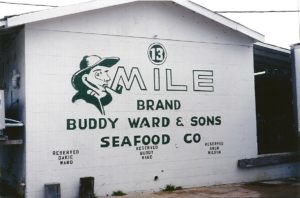 The Ward boys work every aspect of the seafood business. They run processing boats on about 200 leased acres of oysters in Apalachicola Bay. They process shrimp. They own and operate four boats: the Captain T.J., the Donna J., Miss Martha and Buddy’s Boy. And they buy seafood from other fisherman. On this day workers prepare to handle calico scallops fresh from the Gulf. An average haul on one boat alone brings in about 300 gallons:
The Ward boys work every aspect of the seafood business. They run processing boats on about 200 leased acres of oysters in Apalachicola Bay. They process shrimp. They own and operate four boats: the Captain T.J., the Donna J., Miss Martha and Buddy’s Boy. And they buy seafood from other fisherman. On this day workers prepare to handle calico scallops fresh from the Gulf. An average haul on one boat alone brings in about 300 gallons:
Snd of knuckle boom picking up and dropping scallops from a boat to a separator
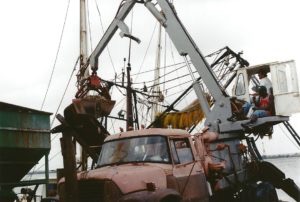 A knuckleboom on the dock scoops up the days harvest from the “Tina Marie” and drops the fresh seafood into a hopper to separate out what Joey calls seafood garbage from the scallops.
A knuckleboom on the dock scoops up the days harvest from the “Tina Marie” and drops the fresh seafood into a hopper to separate out what Joey calls seafood garbage from the scallops.
Donna: “What kind of garbage? Joey: “skinks, conchs, sand dollars. We’ll put it back on the boat and they’ll be dumped back over. You can’t eat none of it, you can’t eat none of it. What you can eat we’ll save. 90% of it scallops anyway.”
Sounds of waterfront up full and under
 As in any family, different members have different skills. While Joey handles the dock, George operates the scallop and shrimp plant. Tommy runs the oyster operation and 42 year old Dakie keeps track of the numbers. He’s the one most vocal about his worries regarding the future of his family’s seafood business. Dakie points to other parts of Florida, where seafood reigned and then disappeared. He’s afraid the same thing will happen to Apalachicola.
As in any family, different members have different skills. While Joey handles the dock, George operates the scallop and shrimp plant. Tommy runs the oyster operation and 42 year old Dakie keeps track of the numbers. He’s the one most vocal about his worries regarding the future of his family’s seafood business. Dakie points to other parts of Florida, where seafood reigned and then disappeared. He’s afraid the same thing will happen to Apalachicola.
Dakie Ward: “Have you been to Tarpon Springs? I’ve been there years ago when there wasn’t nothing but shrimp, snapper houses, unloading houses, stuff all down through there. Key West was the same way. Look at it now. They just kind of weeded the industry out. Go back and look at Tampa Bay years ago. Plenty of oysters, plenty of shrimp, plenty of seafood. Pollution killed the Bay. You can’t get nothing out of Tampa Bay, you can’t get an oyster out of there.”
Retired Seafood operator and fisherman Bobby Kirvin shares Dakie’s concerns. He says the problem’s not just in Florida, it’s a national issue:
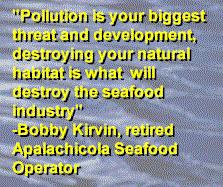 Bobby Kirvin: “Pollution and development is what’s destroying it all. Uh, you can take the Chesapeake Bay area. They totally destroyed the Chesapeake Bay before they started trying to clean it up about 20 years ago. Totally destroyed it. They had a big Menhaden industry up there, oysters, it was the oyster capitol of the world, croakers, all kinds of fish and they just about totally polluted the area from industry. And then they have started cleaning the thing up. Boston Harbor, up until a few years ago, they had dumped every bit of their sewage into the water. Nobody says nothing about that. They’re startin’ to do something in the past few years you know trying to clean the mess up.”
Bobby Kirvin: “Pollution and development is what’s destroying it all. Uh, you can take the Chesapeake Bay area. They totally destroyed the Chesapeake Bay before they started trying to clean it up about 20 years ago. Totally destroyed it. They had a big Menhaden industry up there, oysters, it was the oyster capitol of the world, croakers, all kinds of fish and they just about totally polluted the area from industry. And then they have started cleaning the thing up. Boston Harbor, up until a few years ago, they had dumped every bit of their sewage into the water. Nobody says nothing about that. They’re startin’ to do something in the past few years you know trying to clean the mess up.”
Both Bobby Kirvin and Dakie Ward follow closely the news reports about sewage problems in Atlanta, Georgia affecting the Chattahooche/Apalachicola River system and they’re angry.
Dakie Ward: “You got the city of Atlanta dumps tons and tons of waste in the Flint River coming down the Apalachicola River. But you’ve got the City of Atlanta, that would rather pay a fine to the government, but what good is that doing people? I mean, you know, I just don’t understand it. Water runs down hill, we’re right here at the Gulf. It has nowhere else to go, so it filters out right here in the Apalachicola Bay.”
Bobbie Kirvin: “But pollution, all that junk they’re dumping in Atlanta and they’re paying a fine of so much a day, uh, money ain’t gonna replace it. When it’s destroyed, it’s gonna be gone.”
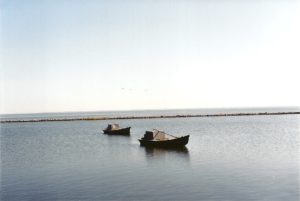 Apalachicola Bay has already suffered a number of setbacks for shellfish harvests. Recent hurricanes and other heavy downpours have also affected salinity levels in the Bay which hurts the oyster’s ability to spawn. Too much rain also taxes the community’s local sewage facilities causing toxic waste to flow into the water. This causes harvest shutdowns.
Apalachicola Bay has already suffered a number of setbacks for shellfish harvests. Recent hurricanes and other heavy downpours have also affected salinity levels in the Bay which hurts the oyster’s ability to spawn. Too much rain also taxes the community’s local sewage facilities causing toxic waste to flow into the water. This causes harvest shutdowns.
During the past five years aquaculture agents for Florida’s Department of Agriculture and Consumer Services have had to close portions if not all of Apalachicola Bay for as many as 467 days. Reasons included red tide, illness outbreaks and hurricanes Allison, Opal and Josephine. Last winter alone, officials closed portions of the Bay for 88 days straight because of heavy rains from El Nino which carried pollution from the river to the bay. Shellfish authorities say they close the Bay most often over problems with elevated fecal Coliform levels in water samples. That’s why Dakie Ward says additional pollution concerns mean bad news for Apalachicola.
Dakie Ward: “You’ve still got your closures for your oysters, because of the pollution, the rainfall, the run off and it’s going to get worse. The more rainfall you get, the more water that comes down from Atlanta, the less your bay is going to produce. Your white shrimp and your brown shrimp breed in the marshes, and after a while the marshes, after the pollution gets there, you aren’t going to have any more breeding area for your shrimp, the juvenile fish. That’s the only complaint I’ve really got–the city of Atlanta. And the government needs to do something about it.”
In fact water quality is one of the two key issues facing government representatives from all three southeastern states—Alabama, Florida and Georgia– as they hammer out an agreement called the Apalachicola-Chattahoochee-Flint (ACF) River Basin Compact. It’s been nicknamed the Tri-State Water War and there are a lot of players in the negotiations with a lot at stake for all three states.

Old Florida River song by Ken Skeens
Any seafood lover in America should take an interest in the health of the Apalachicola River and Bay. That’s how Woody Miley views the issue. Miley’s the Director of the Apalachicola National Marine Estuary. Among his usual duties, he advises Florida’s water negotiators about the pollution status in the river and bay and its effect on seafood production in the Gulf of Mexico. Miley says this should be a national concern.
Bay Sounds
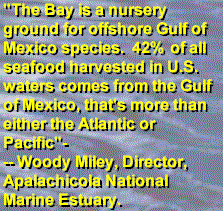 Woody Miley: “42 percent of all seafood harvested in U.S. waters comes from the Gulf of Mexico, that’s more than either the Atlantic or the Pacific. And within the Gulf 95 percent of all species harvested commercially and 85 percent of all species harvested recreationally have to spend a portion of their life cycle in an estuarine system.”
Woody Miley: “42 percent of all seafood harvested in U.S. waters comes from the Gulf of Mexico, that’s more than either the Atlantic or the Pacific. And within the Gulf 95 percent of all species harvested commercially and 85 percent of all species harvested recreationally have to spend a portion of their life cycle in an estuarine system.”
Pollution worries Apalachicola fishermen like Dakie Ward and Bobbie Kirvin. They want Florida’s negotiators to do something about their northern water using neighbors. Sally Bethea is the executive director of Upper Chattahoochee River Keeper, a non-profit organization whose goal is to preserve the Chattahoochee.
Sally Bethea: “Well the Chattahoochee is a very polluted river, we’ve been named one of ten most endangered rivers in the country. For decades Atlanta has dumped raw sewage into the river, it has not met its permits. Of course when sewage, under treated sewage or raw sewage is dumped in a river like the Chattahoochee you have serious bacteria problems causing potential threats to drinking water supplies and recreation down stream. Our research indicates by and large that pollution extends maybe 100 or so miles down the stream.”
Bethea says her group organized a lawsuit in 1995 against the city of Atlanta concerning its sewage problems.
Sally Bethea: “The problem is primarily associated with the city of Atlanta’s old and decrepit and under-maintained sewage system, 100 year old pipes, the money has just not been spent to upgrade these systems.”
The Riverkeeper group won the case in 1998. The city of Atlanta has until 2007 to upgrade its sewage system. Robert Kerr is the Director of the Pollution Prevention Assistance Division with Georgia’s Department of Natural Resources. He’s also Georgia’s water negotiator in the Tri-State Water War. Kerr says since the lawsuit, sewage system improvements have already begun on Atlanta’s end of the “drain pipe.
Bob Kerr: “The City of Atlanta has been fined as everybody knows. They’ve made major efforts to invest a lot of money into cleaning up the combined storm sewer overflow facilities. I think the water quality is improving, not degrading. And we have committed in the compacts themselves that all the water quality laws will be met. So we will have to meet and do that.”
Estuary director Miley points out the dams and reservoirs along the Chattahoochee River act like a filter.
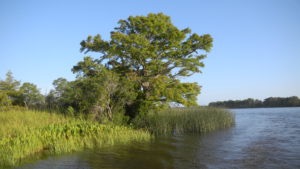 Woody Miley: “The reservoirs that are in Georgia act as a sump. The pollution basically stays in the reservoir system and once it gets into Florida our flood plains and our marshes are relatively intact. They filter pollution that would otherwise end up in our bay. ”
Woody Miley: “The reservoirs that are in Georgia act as a sump. The pollution basically stays in the reservoir system and once it gets into Florida our flood plains and our marshes are relatively intact. They filter pollution that would otherwise end up in our bay. ”
Sound of rainwater flowing
Riverkeeper’s Bethea says contrary to popular belief there is very little outright toxic dumping into the Chattahoochee River. She points out most of the pollution is an indirect consequence from industrial and residential development in Atlanta.
Sally Bethea: ” When a developer comes in to build a subdivision, a large commercial development, typically they come in and scrape off that carpet, that natural vegetative carpet. And so when it rains and you have that hard rainfall on that Georgia red clay, you end up with the mud and dirt flowing down to the lowest level into small streams, larger ones, and then into the river. And most people don’t think of sediment and eroded soil as a pollutant but it very much is. It destroys the life in our rivers. It causes the pesticides and chemicals and oils and greases that catches onto the particles as it flows over the land and all that ends up in our rivers.”
 Estuary director Miley says right now the estuary system between the river and the bay is relatively healthy and he points to the variety of species of fish utilizing the rich waters.
Estuary director Miley says right now the estuary system between the river and the bay is relatively healthy and he points to the variety of species of fish utilizing the rich waters.
Woody Miley: “Blue crabs, for example, migrate as much as 300 miles to spawn in Apalachicola Bay. They send their larval and juvenile stages in our marshes and then they scatter out all over the Gulf. So do shrimp and so do fin fish. So the productivity of the Gulf of Mexico is almost totally dependent on coastal productivity, estuarine productivity and Apalachicola is among the best.”
Miley says the waters of the river and bay serve as home to one of the most diverse ecosystems on the continent with more than 1300 species of plants including the recently discovered Apalachicola Daisy. In fact, the critically acclaimed 1997 movie “Ulee’s Gold,” filmed in the area, spotlights the Apalachicola River’s large and dense population of black Tupelo gum trees.
Movie clip from Ulee’s Gold
The trees grow in the swamps and yield blossoms used in harvesting the area’s famous Tupelo honey. Miley says only clean waters allow this kind of ecological diversity to thrive.
 Woody Miley: “Species diversity here for amphibians and reptiles exceeds that of any place in North America north of Mexico. We are as productive from an estuarine harvest standpoint as anywhere else. In fact, Apalachicola’s estuary is one of, if not, the most productive estuarine systems in the northern hemisphere based on a production per acre basis. We’re even more productive than the Chesapeake,although that wasn’t always true.”
Woody Miley: “Species diversity here for amphibians and reptiles exceeds that of any place in North America north of Mexico. We are as productive from an estuarine harvest standpoint as anywhere else. In fact, Apalachicola’s estuary is one of, if not, the most productive estuarine systems in the northern hemisphere based on a production per acre basis. We’re even more productive than the Chesapeake,although that wasn’t always true.”
Bay sounds
So although sewage treatment facilities and urban runoff in northern Georgia around metro Atlanta cause river pollution for nearly 100 miles downstream scientific data from water managers apparently supports Miley’s theory that the dams and reservoirs hold back the pollution. The manager of the water protection branch of Georgia’s Environmental Protection Division says when the water of the Chattahoochee crosses over the Florida state line, it meets current Georgia water quality standards which meets EPA criteria.
If the water is okay when it comes into Florida, why does fecal coliform or the bacteria from human and animal waste show up in Apalachicola Bay? Florida’s water managers say the state needs to look in its own backyard. Some of the bacteria shows up when water naturally drains off the flood plain. They say there are too many septic tanks along the coast and water managers say Apalachicola’s own sewage facilities need upgrading.
To help with the situation Florida lawmakers recently made it mandatory for all commercial fishing boats to carry port-o-lets on board. Differences of opinion about pollution reflect the temper of the current water negotiations over water quantity. This arena of the water wars causes most of the debate among the players involved. Not only are they debating water quality, but how much water flows through each state. We’ll take a look at the water quantity debate later in this program.
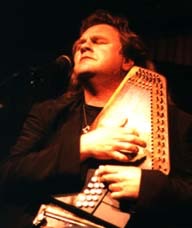
Harvey Reid’s song Circles up full and fades under
Throughout history, folks who’ve lived along the Apalachicola have faced adversities. Industries have come and gone many times.
Frank Miller (tourist) bite: This town has lived and died about three or four different times, and you don’t see many towns that do that.
Circles up full and under
Some may say Apalachicola has come full circle in the past 178 years. In the early 1800’s the South recognized the panhandle community as the third largest cotton port on the Gulf Coast, ranking only after New Orleans and Mobile. The town’s first unofficial name was Cotton Town. But, Florida’s first railroad drew away most of the cotton trade. Devastating hurricanes blew through gulf coast communities in the 1830’s and 40’s not to mention yellow fever epidemics and the Civil War.
Circles up full and under
In the 1880’s the town hit another economic boom with the beginning of cypress milling. Lifelong resident, 96 year old Homer Marks, remembers where many of the old sawmills used to stand.

Homer Marks: “The Cypress Lumber company come down here from I think Baltimore or somewhere up in there in ’84 and then there’s a big city out there you turn off just before you get, before you get to my place out there, and just beyond me was Coombs Mill. It burnt I think in 1910. And then there was the Loxley Mill, the Coombs Mill and the Cypress Lumber Company and the Kimber Mill was right here in town, but it was gone. It went with the fire of 1900.”
The new pastor of the First United Methodist Church of Apalachicola, Reverend Brian Fowler, has heard a lot about that turn of the century blaze.
Fowler: “In 1900 the pastor’s wife had left a pan of grease on the stove evidently and had forgotten about it and started the fire and the wind blew it across the street to the Methodist Church and it went to the rest of the town from there.”
The congregation of the First United Methodist Church rebuilt.
Music from a church service in Apalachicola
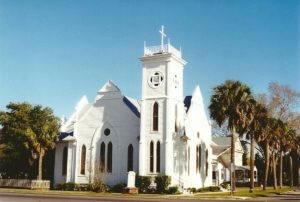 99 years after the fire about 200 people belong to the church. It’s one of about 15 churches in this town of three thousand residents and Fowler says allegiance is strong.
99 years after the fire about 200 people belong to the church. It’s one of about 15 churches in this town of three thousand residents and Fowler says allegiance is strong.
Fowler: “I’d say probably about half my congregation has been here for generations. For example, the mayor of the town is a member here and his family is one of the founding families, the church is 160 years old and he told me just the other night that he sat with six generations of his family in this church and how many people can say that.”
That mayor is Bobby Howell.
Bobby Howell: “I retired from the military in 28 feb. 89. I spent a year having cancer operations and then I was elected to mayor in the September of 91. And then I was re-elected in September of 95 and there’s not going to be a third time. My wife said she was leaving me if I ran again.”
In a small community like Apalachicola, everyone seems to know everyone else, especially a person’s history, good times and bad times. So it wouldn’t be surprising to hear that the current mayor, Bobby Howell, has a tie to one of the town’s oldest residents, Homer Marks. Howell is actually a descendant of the family that affects Homer’s life every day. It’s the kind of story that transcends time. It’s a love story really.
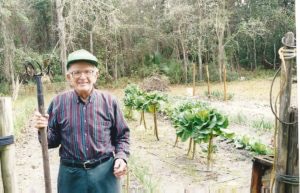
You see everybody knows Homer Marks for the many businesses he’s run through the years. He’s been in the wholesale grocery business, the ice business that catered to the seafood operators. He’s been a bee keeper in the Tupelo honey business. He had an outboard marine business.
But when locals see him drive down the streets of Apalachicola (he has a license until 2001) they all usually know where he’s going. That’s the way it is in a small town with one blinking light. Homer Marks is usually headed to one of his two favorite spots. One is his garden on the edge of town.
Fade up Homer talking about his garden crops
What touches most people is how Homer Marks drives almost daily to one of the local cemeteries to tend to the grave stones of the people he’s loved in his life.
Homer Marks: “Yeah, I got my first girlfriend out there, my wife’s out there, my second girlfriend’s out there.”
He still finds it the most difficult to talk about his first girlfriend. Homer was 21 years old when Margaret Howell died in 1923 at the age of 17. He’s never quite gotten over Margaret’s death.
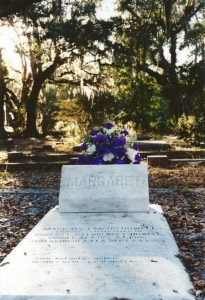
Homer Marks: “Yeah, that sort of still touches me. I can’t talk about it. There was a day school opened. A boy had one of those pickup things, one of those platforms and three girls and one boy went out this here road on the way to St. Joe. They weren’t going to St. Joe, but it’s called three mile turn, and he turned in that sand and it turned over and it hurt the other two girls but it killed her. Donna asks: Were you going to get married? Homer Marks: “As soon as we got enough to eat we were going to get married, yeah. It’s a real touchy subject with me. I just ain’t man enough to stand up on this.”
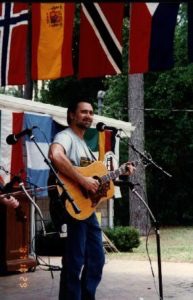
Margaret song by Mike Jurgensen up full
Homer Marks spent most of his life only a few blocks from the house he was born in, close to the Methodist Church before the city put in that blinking light. He remembers the start up and demise of virtually every business venture in Apalachicola. In many ways he represents the paradox facing many old fishing communities like Apalachicola. He reflects the kind of old world gentility, history and color that tourists seek. Yet that creates another threat to the town’s culture and history, to the river, estuaries and Bay that the seafood industry relies on.
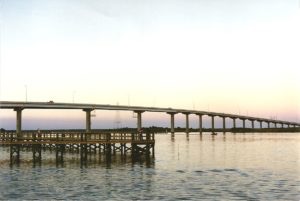
Ironically, Homer Marks’s father had a role in deciding where to build the key bridge that connects Apalachicola to it’s East Point neighbor across the Bay. The highway bridge construction in 1935 changed the community forever.
Car sounds with Bing Crosby song Apalachicola, FLA
Florida seafood towns like Miami, Key West, Tampa, and Tarpon Springs have historically attracted tourists. Apalachicola now attracts tourists, ironic since Franklin County officials still call it the “Forgotten Coast” People want to see a part of old Florida. Many credit eco-tourism for the new interest in the fishing town and the big money it brings to some of the old and new businesses.
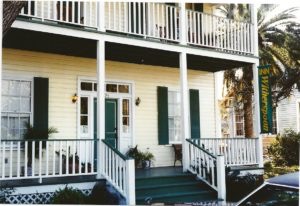
Many visitors came back to stay. Several have taken out loans from the local banks in the area to remodel historic homes. The Gibson, the Coombs and the Witherspoon all cater to the bed and breakfast crowd. Feelings are mixed about this next economic phase the community faces.

The River song by Steve Gillette with paddlewheel sounds up full
Phyllis Blake, tour operator: “Business has been good. of course, the seasons vary.”
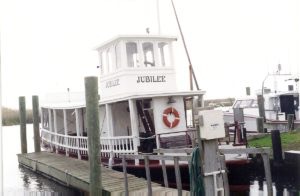 That’s Phyllis Blake talking from the stern of the Jubilee. It’s a paddle-boat she uses to guide visitors around Apalachicola Bay and the mouth of the Apalachicola River.
That’s Phyllis Blake talking from the stern of the Jubilee. It’s a paddle-boat she uses to guide visitors around Apalachicola Bay and the mouth of the Apalachicola River.
The River song up full and under
 Her husband Danny built the boat – a hobby of his that he’s made into a career. The two moved to Apalachicola about eight years ago in true maritime fashion – They came by sea from Vicksburg, Mississippi – on a sailboat Danny had made them – The area was love at first sight.
Her husband Danny built the boat – a hobby of his that he’s made into a career. The two moved to Apalachicola about eight years ago in true maritime fashion – They came by sea from Vicksburg, Mississippi – on a sailboat Danny had made them – The area was love at first sight.
Phyllis Blake: “It was like a part of the world you thought didn’t exist anymore. And that’s why people want to be here I think. I mean there’s almost a magic in the town. It’s something you long for. Something maybe you read about or saw in a movie.”
Her tour is one of history – of Native Americans that once held the land – and of a blooming cotton industry that fed the town making it grow into a major southern port. And of course, there’s the fishing industry.
 Phyllis Blake: “They love to see the shrimp boats and the fishing boats and the oyster boats and they just think it’s marvelous that people are able to do that and quite colorful and wonderful.”
Phyllis Blake: “They love to see the shrimp boats and the fishing boats and the oyster boats and they just think it’s marvelous that people are able to do that and quite colorful and wonderful.”
Just up the waterfront – another tour. this one offered by Gibby Conrad. He’s also new to the area. He and his wife moved here from New Orleans about two years ago.
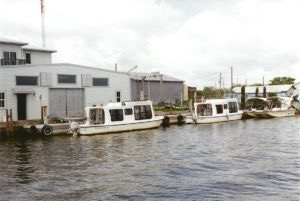 Gibby Conrad: “Well, i do kind of a combination eco-tour and history tour. We get a lot of people from up north, so-called snowbirds and those actually the type of people interested in my trip. They’re bird watchers, and they’re interested in nature and that kind of thing.”
Gibby Conrad: “Well, i do kind of a combination eco-tour and history tour. We get a lot of people from up north, so-called snowbirds and those actually the type of people interested in my trip. They’re bird watchers, and they’re interested in nature and that kind of thing.”
And so it goes all along the Apalachicola water-front. Eco-tours are popping up all over the place. There’s one for fishing and another for snorkeling… and now tourists can even take a sail on a piece of history.
Sound of Danny Blake talking about the Governor’s Stone sailboat
When he’s not doing paddlewheel tours, Danny Blake spends his time fixing up an all wood sailing vessel. It’s a Mississippi ship called the Governor stone and it dates back to 1877. The city’s maritime museum board commissioned the boat’s repair. Kristen Anderson sits on the museum board. She says While the Governor’s Stone once carried cargo, now it hauls tourists.
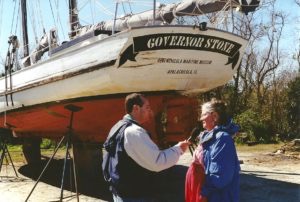 Kristen Anderson: “Her new job is carrying passengers as cargo basically and teaching people about the history of the Gulf Coast in particular, maritime history.”
Kristen Anderson: “Her new job is carrying passengers as cargo basically and teaching people about the history of the Gulf Coast in particular, maritime history.”
Apalachicola officials are banking on all the water ventures bring in more tourism dollars. So, is this isolated town on Florida’s gulf coast still a real fishing village or simply the next major Florida tourist trap? one thing everybody does notice – Apalachicola is changing.
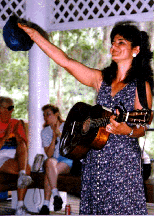
Changes in the Wind song by Jeanie Fitchen fades up
Phyllis Blake: “I understand their feeling. It is changing. The way of life will change.”
Steve Davis, tourist: “It used to be almost totally sand dunes, you know. Now it’s all condos and houses and so forth.”
Phyllis Blake: “I know it’s happening all over America in small towns – especially along the coast.”
Billy Cooke, resident: “Back in the mid-eighties, the Gibson Hotel was just a flop house, and nothing was downtown hardly at all.”
Music cross fades with sound from Gibson Inn
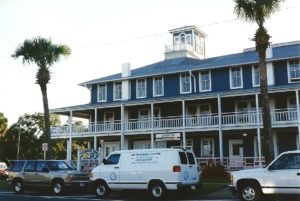 The Gibson Inn. People in town can’t seem to stop talking about it and tourists can’t miss it.
The Gibson Inn. People in town can’t seem to stop talking about it and tourists can’t miss it.

Michael Koun, Gibson manager: “The hotel was a Victorian hotel. It was built in 1907 with the fine woods and the construction of the hotel, what we’ve tried to bring back was the way it was in 1907.”
Michael Koun manages the Gibson and owns it along with his brother and another business partner. The Gibson is the first hotel motorists see coming off the Highway 98 bridge leading into Apalachicola.
 Michael Koun: It was about a dollar and a quarter when it first opened, and I think it was two or three dollars in the twenties. ..and it was a bit more formal back then.”
Michael Koun: It was about a dollar and a quarter when it first opened, and I think it was two or three dollars in the twenties. ..and it was a bit more formal back then.”
The Gibson was built as a hotel more than ninety years ago. Fifteen years later two sisters, Annie and Sunshine Gibson, bought the hotel passing along a namesake. In 1983 Koun went in on the purchase leaving his life in Williamsburg, Virginia far behind. The Gibson then only operated as storefronts on the ground floor.
 Koun refurbished the top two stories and cleared out the businesses below making way for a lobby, a bar and a restaurant that now serves three meals a day.
Koun refurbished the top two stories and cleared out the businesses below making way for a lobby, a bar and a restaurant that now serves three meals a day.
Sound of Gibson Inn up full and fade under
Apalachicola Mayor – Bobby Howell.
Bobby Howell, Mayor: “The Gibson Hotel might have been the beginning of the restoration in the community… well, I would give them more credit than anybody when they opened that. Yes, I would, personally.”
The risk paid off. The Gibson is now one of the most thriving inns in Apalachicola. And a block away Pamela Barnes is booked solid for the weekend at the Coombs Inn.
Pamela Barnes, Coombs Manager: “So we have 17 bedrooms. We have a carriage house apartment. We have meeting space, banquet space.”
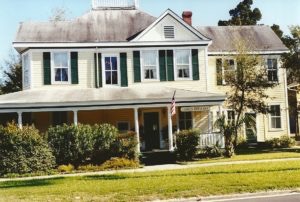
In 1911 Mr. Coombs moved among the rich and famous in Apalachicola’s silk stocking district. He owned a lumber mill down on the waterfront. He built his home from the wood he milled. A black cypress lentil crowns the grand entrance.
Pamela Barnes: “When we first moved here a year ago, on Fridays it used to be a walk-in town. And now you’ve gotta make reservations to come here.”
The town does seem to be booming with renovation projects on each block. The population’s up, especially over the summer…60-thousand people crammed into and around an area that’s used to only about 10-thousand during the slow months. The tourist interest concerns some of the city’s long-time residents, including retired fisherman Bobby Kirvin.
Bobby Kirvin: “That’s the problem. If they can show me a place that has developed and kept the seafood industry. Key West? Viable seafood industry? You can’t even carry a damn commercial boat into Key West now. You have to go to Stock Island. Tourists took it all over.”
The seafood industry, of course, is the primary concern. Gibby Conrad:
 Gibby Conrad: “Unfortunately, money is what drives things and other than the seafood industry, there isn’t very much here and so tourism is definitely the up-and-coming thing and it’s a real delicate balance of keeping things the way that people who come here originally like them and still, um, still have a viable industry in tourism.”
Gibby Conrad: “Unfortunately, money is what drives things and other than the seafood industry, there isn’t very much here and so tourism is definitely the up-and-coming thing and it’s a real delicate balance of keeping things the way that people who come here originally like them and still, um, still have a viable industry in tourism.”
Cliff Butler is President of Gulf State Bank. This locally owned bank made several start-up loans to tourism ventures, including the Gibson Inn, in an effort to spark economic growth in Apalachicola. Butler’s philosophy smacks of pragmatism.
Cliff Butler: “The seafood industry is not what it was, what with all the new rules. Also, adverse publicity on, let’s say oysters, has hurt the demand from time to time, and the tourist industry has allowed an alternative benefit where family members could work and incomes could be supplemented during the times when the seafood industry was not thriving.”
The new tourism twist in the economy has brought on some traffic headaches in this small town.
Oyster Radio Station sound plus traffic sounds
Michael Allen heads up the news department at Oyster Radio.
Michael Allen, Oyster Radio: “Here, three cars in a row is a traffic jam.”
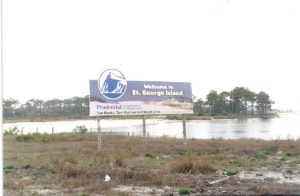 Traffic is tighter on the bridge out to Saint George Island as well. Many people who make their living in Apalachicola make their beds on Saint George Island. It’s the barrier island that forms the fertile seafood nursery known as Apalachicola Bay. Michael Allen spent his childhood on the island.
Traffic is tighter on the bridge out to Saint George Island as well. Many people who make their living in Apalachicola make their beds on Saint George Island. It’s the barrier island that forms the fertile seafood nursery known as Apalachicola Bay. Michael Allen spent his childhood on the island.
Michael Allen: “When I was growing up, there were no houses. There were maybe 10, 15, 20 houses. You go over there, I mean you’ve seen it. There are no lots left open anymore. You have these things we call “skinny-minis,” these little houses by the public beach. You can’t even see the water from the road anymore. I think it’s a travesty.”
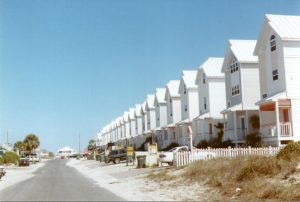 The edge of Saint George Island is lined with thin waterfront condominiums. Each is three stories high and only the width of a two-car garage. Every bungalow has a name. It’s all time share. And there’s no room between any of them.
The edge of Saint George Island is lined with thin waterfront condominiums. Each is three stories high and only the width of a two-car garage. Every bungalow has a name. It’s all time share. And there’s no room between any of them.
Bobby Kirvin: “And when you stack houses side by side down that whole dang island, which will eventually happen, you can forget any kind of commercial oyster industry or anything else in Franklin county.
Bobby Kirvin’s worried about the environmental impact.
 Bobby Kirvin, retired fisherman: “The development of St. George Island will destroy Apalachicola Bay eventually. It’s all on septic tanks. And you can’t tell me if you put enough septic tanks in the ground, it won’t eventually pollute the bay.”
Bobby Kirvin, retired fisherman: “The development of St. George Island will destroy Apalachicola Bay eventually. It’s all on septic tanks. And you can’t tell me if you put enough septic tanks in the ground, it won’t eventually pollute the bay.”
So, the city’s put a three-story limit on new development and issued a comprehensive plan for the area. But there’s still no way to put a cap on the growing tourism market.
Phyllis Blake: “This is America. You can’t change where people. If people want to move somewhere, you can’t do anything about it.”
But Bobby Kirvin’s memories are shaded by a sad history, the way Florida’s last great seaports have been shattered by tourism.

The song Southwind played by Nick Blake down under
Bobby Kirvin: “Tarpon Springs was just like Apalachicola. When I was a kid, I went to Tarpon several times. A little, laid-back community. And now, what are the commercial people doing now – the sponge divers and all? They’re putting on exhibits for the tourists! And that’s it.”
The manager of the Gibson Inn saw much the same thing happen to his hometown.
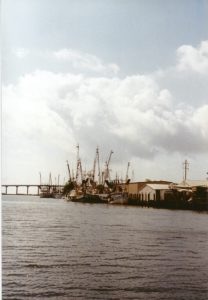 Michael Koun: “I don’t want this town to be another Williamsburg. One of the things people like about this town is the town itself has character and there’s characters in the town, including the new ones and the old ones. But it has character and has sort of a working relationship. The new people move in and don’t always understand where the old people are coming from and the old people don’t always understand where the new ones are coming from. But there’s sort of an understanding with the people who have moved in, I feel, that the waterfront is going to stay the waterfront and let’s keep it the waterfront. But part of the character of the town are those shrimp boats out there and the men that work them, and the families that work them. And that adds character to the town.”
Michael Koun: “I don’t want this town to be another Williamsburg. One of the things people like about this town is the town itself has character and there’s characters in the town, including the new ones and the old ones. But it has character and has sort of a working relationship. The new people move in and don’t always understand where the old people are coming from and the old people don’t always understand where the new ones are coming from. But there’s sort of an understanding with the people who have moved in, I feel, that the waterfront is going to stay the waterfront and let’s keep it the waterfront. But part of the character of the town are those shrimp boats out there and the men that work them, and the families that work them. And that adds character to the town.”
And out on the water the feeling is shared by tour boat operators. They too say they want to see the town preserved. They say they’re on a mission to educate tourists – not lure them in.
Gibby Conrad: “I do think the two things can exist, and I think one of the ways they can co-exist is by informing the tourists about what goes on in a working seafood port, what those guys, what those fishermen go through and what the results of what some of the laws in the name of ecology wind up doing to the people who have to use them day to day.”
Sound of waterfront and music up full and under
Hurricanes , water quality issues, ecotourism, development – all challenges this small but growing community faces. Yet, for now, the seafood industry continues as the backbone of Apalachicola’s economy. Oysters flourish because of what many consider to be a “magical” balance between fresh water and salt water in the Bay as the Apalachicola River converges with the Gulf of Mexico. Scientists say maintaining this balance is the key to preserving the oyster industry. As their deadline nears tri-state water negotiators are trying to invent a water quantity formula agreeable to Alabama, Florida, and Georgia.
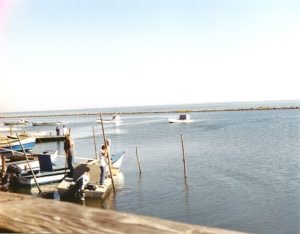 How did this water war begin? 10 years ago the Army Corps of Engineers proposed reallocating water from Lake Lanier, just north of Atlanta, to supply the metro area’s growing water needs. The state of Georgia intended to build a reservoir on the Tallapoosa River in West Georgia. Alabama officials worried this would reduce their supply of water needed for hydro power. They filed a lawsuit against Georgia and Florida joined in. The three states decided to try and solve this issue on their own, resulting in the tri-state water compact negotiations.
How did this water war begin? 10 years ago the Army Corps of Engineers proposed reallocating water from Lake Lanier, just north of Atlanta, to supply the metro area’s growing water needs. The state of Georgia intended to build a reservoir on the Tallapoosa River in West Georgia. Alabama officials worried this would reduce their supply of water needed for hydro power. They filed a lawsuit against Georgia and Florida joined in. The three states decided to try and solve this issue on their own, resulting in the tri-state water compact negotiations.
The three states have four broad goals in mind. Metro Atlanta’s thirst demands more drinking water. South Georgia farmers insist on irrigating their peanuts, cotton, and corn. Alabama needs hydropower and navigational use down the Chattahoochee and Apalachicola Rivers. And if these demands weren’t complicated enough, Apalachicola’s seafood industry requires fresh water flow for a diverse and healthy bay.
Steve Leitman is the environmental scientist for the N.W. Florida Water Management District. Leitman says the nutrients which help the aquatic life flourish in the Apalachicola River and Bay come from a variety of sources.
Steve Leitman: “…its water shed extends far up into Georgia that it gets its biotic influences from the Appalachian mountains from the Piedmont and from the coastal plain.“
Lindsey Thomas represents the federal government in these negotiations. Thomas worries Alabama, Georgia, and Florida may not meet their December 31st deadline.
Lindsey Thomas: “I would say right now things are not moving like I would like to see them move if we are going to get an agreement. And I think right now time is running out.”
They couldn’t agree last year, so they extended the talks through this year. Federal representative Lindsey says negotiations have slowed partly because each state has a new governor. Matthew Kales is the program director for the non-profit Upper Chattahoochee River Keeper organization. Though he differs with state officials, he describes Georgia’s philosophical approach to the compact.
Matthew Kales: “Georgia’s idea is to manage the reservoirs in the system as a whole as if drought were imminent, keep as much water as possible behind the dam while meeting the needs of downstream neighbors.”
Robert Kerr is Georgia’s representative in the negotiations.
 Robert Kerr: “Can we get an agreement? We hope so because what we are looking at is what we consider to be a reasonable use and a reasonable return of the waters that we use some 200 plus miles north of Apalachicola Bay. And we don’t anticipate that the activities in the metro Atlanta area are going to have that material effect down there.”
Robert Kerr: “Can we get an agreement? We hope so because what we are looking at is what we consider to be a reasonable use and a reasonable return of the waters that we use some 200 plus miles north of Apalachicola Bay. And we don’t anticipate that the activities in the metro Atlanta area are going to have that material effect down there.”
Not everyone agrees. For the last five years parties from all three states have jointly developed databases in order to analyze each others statistics and ideas. Florida’s Environmental Scientist Steve Leitman says everyone’s trying to look at this issue from the point of view of what is good for the entire river basin system.
Steve Leitman: “And so what this five year period did was it allowed this development of a mentality or a consciousness in the basin where people could start seeing it more as a whole system.”
Georgia negotiator Kerr says Alabama and Florida shouldn’t worry so much about how much water’s coming down the river.
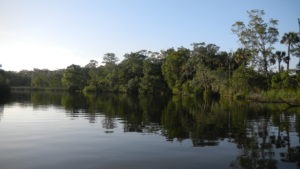 Robert Kerr: “The states of Alabama and Florida do not need an agreement in the sense that if they don’t get an agreement their not going to get any water. We’re going to be providing water downstream, we have obligations within our own state.”
Robert Kerr: “The states of Alabama and Florida do not need an agreement in the sense that if they don’t get an agreement their not going to get any water. We’re going to be providing water downstream, we have obligations within our own state.”
But lifelong Apalachicola businessman and seafood operator Bobby Kirvin doesn’t share negotiator Kerr’s opinion and says look what happened in the water wars out West:
Bobby Kirvin: “How much water comes out the Colorado at the end of it now, none. You can walk across it dry footed because they utilize every drop of it somewhere along the way.”
As already mentioned, one of the sticking points in these talks is metro Atlanta’s growth. It takes in up to 20 counties. Urban sprawl characterizes Atlanta. The current population of about 3.7 million people is expected to balloon to nearly 5-million residents within 50 years.
Matthew Kales: “What we’re seeing here is a metro area that is writing natural resources checks, it’s writing growth checks that it can’t cash. We’ve exceeded our carrying capacity and the tri-state water war is very much a wake up call to that affect.”
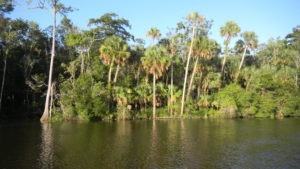 Kales predicts in any future agreement metro Atlanta’s needs may outweigh those of the farmers in southern Georgia. Lake Lanier is a man made lake located just north of the city. It holds about two thirds of the water storage for the Chattahoochee and Apalachicola Rivers. Steve Leitman of the Northwest Florida Water Management District says any compact agreement may have to include releasing more water from Lake Lanier for downstream needs. Another bone of contention.
Kales predicts in any future agreement metro Atlanta’s needs may outweigh those of the farmers in southern Georgia. Lake Lanier is a man made lake located just north of the city. It holds about two thirds of the water storage for the Chattahoochee and Apalachicola Rivers. Steve Leitman of the Northwest Florida Water Management District says any compact agreement may have to include releasing more water from Lake Lanier for downstream needs. Another bone of contention.
Steve Leitman: “Lake Lanier is set up to be managed to fluctuate 35 feet. If it changes four feet the people around it are screaming saying you can’t lower it anymore. And so a lot of this management capability that was paid for by tax payer money really has turned around to become lake front property for the residents of the area.”
Georgia negotiator Robert Kerr claims his state needs flexibility in water planning and this puts Georgia at odds with Florida in the current talks.
Robert Kerr: ” Florida simply wants us to agree to an ongoing evaluation for about 10 years and a growth out to 2010 and then if we can’t reach agreement we cut off any additional growth out of the system, well obviously 10 years of certainty is not sufficient, so that’s the major problem there.”
In other words, adaptive management. It’s a new concept. River Keeper’s Matthew Kales:
Matthew Kales: “Adaptive management is a very basic ecosystem management tool or concept whereby you monitor a system after a management plan has been implemented. You see what the feedback from that system is chemically, biologically, economically, and then you adjust accordingly so that that management plan is ecologically sound in the best interests of the water dependent entities.”
Apalachicola estuary director Miley points out how other nations suffered when they ignored such techniques.
Woody Miley: “With the demise of the Soviet Union and our access to their scientific literature and their scientists, and uh, the Aerial Sea lost a 1.2 billion dollar a year seafood industry. Same horror story for the Azov, the Caspian, the vast Volga delta and the number one culprit in their research was changing the fresh water flow into those systems.”
In the end it is still the oyster industry which supports the livelihood of so many of Apalachicola’s residents. Miley says balance between the Gulf of Mexico’s salt water and the river’s fresh water is vital to this industry’s survival.
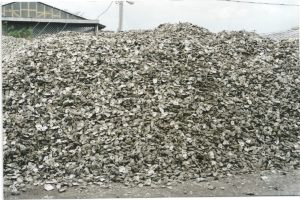 Woody Miley: “But if we lose fresh water and the bay goes more salty, then all the parasites, predators, and diseases in the Gulf move in and devastate the oyster bars.
Woody Miley: “But if we lose fresh water and the bay goes more salty, then all the parasites, predators, and diseases in the Gulf move in and devastate the oyster bars.
With Florida, Georgia, and Alabama drawing off this resource, any future agreed upon compact will be the first of its kind in the United States. Federal Commissioner Thomas.
Lindsey Thomas: “It gives the three states the opportunity to make their own determinations about these waters here to a great extent, as how to manage them, how to steward them keeping it within the confines of existing federal law, clean water act, clean drinking act, and those kinds of things.”
Thomas along with nine federal agencies including the Army Corps of Engineers, the Department of Interior, and the U.S. Fish and Wildlife Service will have to give the final stamp of approval within 255 days of any final agreement. If Florida, Georgia, and Alabama cannot reach an agreement, the issue could go before the U.S. Supreme Court and drag out another ten years. Estuary Director Miley.
 Woody Miley: “This is a regional resource, its going to take all three states and if we’re going to manage this system in a way that all the user groups can continue to use it, and everyone needs to realize that a fish fillet does not originate at Publix.”
Woody Miley: “This is a regional resource, its going to take all three states and if we’re going to manage this system in a way that all the user groups can continue to use it, and everyone needs to realize that a fish fillet does not originate at Publix.”
Miley stresses if Americans want to continue buying fresh seafood at their local market, they must take an interest in what’s happening in this Tri-State Water War before a major resource disappears.
One of the biggest unknown factors in Apalachicola’s future surrounds the question of what will happen to the more than 70-thousand acres in Franklin County owned by one of Florida’s biggest real estate development companies. St. Joe Company has more than one million acres of land in the state. Most of that acreage sits in the Florida Panhandle. A company spokesman, says most of it will remain timberland. St. Joe does have a variety of projects in planning stages or underway including: beach clubs, hotels, condos and a marina.
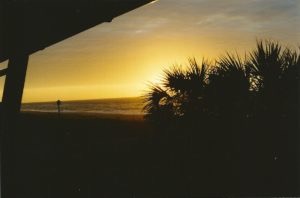 What worries environmentalists is what St. Joe plans to do with a 7 ½ mile stretch of beach front it owns on the Gulf in Franklin and neighboring Wakulla Counties. For now the area remains undeveloped, but Franklin County’s planning director says it’s just a matter of time. He says until the community upgrades its already over-capacity sewage treatment facility, the community’s not ready for any major projects. St. Joe Company’s spokesman says assisting the community with their sewage treatment problems is something they’d be willing to take a look at. Meanwhile, no one disputes the fact that like the outcome of the current Tri-State Water War, St. Joe Company has the power to reshape the future of this historic, seafood community.
What worries environmentalists is what St. Joe plans to do with a 7 ½ mile stretch of beach front it owns on the Gulf in Franklin and neighboring Wakulla Counties. For now the area remains undeveloped, but Franklin County’s planning director says it’s just a matter of time. He says until the community upgrades its already over-capacity sewage treatment facility, the community’s not ready for any major projects. St. Joe Company’s spokesman says assisting the community with their sewage treatment problems is something they’d be willing to take a look at. Meanwhile, no one disputes the fact that like the outcome of the current Tri-State Water War, St. Joe Company has the power to reshape the future of this historic, seafood community.
Music Drifts Along This River song by Mike Jurgensen up full
Listen to the radio documentary. See additional updates and material related to the Tri-State Water War . Learn more about the artists performing in the documentary.
CREDITS:
This program was co-produced by Donna Green-Townsend and Bill Beckett. Associate producers were Joshua Azriel and Daniel Beasley. Jim Bickerstaff and Gravity Productions provided additional recording services. For more information about the Tri-State Water War negotiations or this program click here.
Funding for this program was provided by a grant from George Floyd in memory of Jim Floyd and George Kirvin, two of the earliest heralds of the rivers and bays and their value as an undisturbed natural resource.
